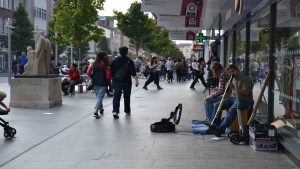
The company undertook a survey to ask UK consumers how they felt about the current state of the high street. The report delves into the solutions being suggested, to see if there’s a light at the end of the tunnel for the high streets.
It’s no secret that the UK high street hasn’t been doing too well of late. Despite widespread public awareness and calls to support local city centres, 2018 has proven a dire reminder of the issue with many well-known brands disappearing from the high street.
The report’s key findings include:
- Three out of four of respondents were saddened by the decline of high streets while a shocking one in four admit they’re indifferent. The latter is likely due to apathy with decades of outdated planning.
- Twenty percent claimed that their visits to the high street are months apart. This shows that they aren’t currently finding value in what’s on offer.
- More than half of those surveyed (56%) said that they prefer to spend their money with independent local retailers. This is in contrast to spending with the big-name chains.
- Thirty eight percent stated that they do most or all of their shopping online. More than the 28% who favour in-store purchases and 34% who claim it’s 50/50.
- Footfall was down by 4.2% across the entire UK between the end of 2017 and the end of 2018. This is an equivalent to a drop of 3 million high street customers.
2018’s high street troubles – a year of store closures
In 2018, 1,300+ store closures had been reported as many large retailers focused on maximising profits by closing branches. This has left unused units littering high streets across the country. Recent findings by leading retail analysts uncovered that this has led to over 7 million sq ft of UK retail space sitting unused.
This won’t be helped by lowering footfall. Twenty percent of people surveyed claim that there was over a month between their visits to the local high street.
Experience-focused stores replacing traditional retailers
So, who’s bringing in the consumers into the high street and who’s shutting up shop? According to the Centre for Retail Research, the businesses that are thriving in 2018 include:
- Convenience stores
- Coffee shops
- Vape shops
- Restaurants, bars and cafes
- Healing and Treatments.
Those retailers who are experiencing a tough time and closing include:
- Fashion and clothing
- Music, games and DVD
- Bookshops
- Antique stores
- Household goods.
The report suggests this is a great indicator of what people actually want from their high street experience. It mirrors the research into what the future holds. Respondents supported this outlook by stating that they preferred to shop at independent local retailers, as opposed to mainstream brands.
Many of the retailers fighting survival are traditional retail operations. In contrast the retailers thriving and opening up shops are more in the way of social and experience-driven businesses.
The results follow the trend of the survey, with over half of respondents (56%) opting for independent retailers. Shops who are more likely to offer a tailored service and a more personal touch.
This was also supported by one of the Daily Telegraph’s Top 25 Property Influencers. Vicki Wusche, Property Influencer from London believes that looking back could help us move retail forwards.
According to Wusche, “We need to radically rethink the way that people shop at brick and mortar retailers. I would like to see high street shops return to older values of experience-driven customer service. I would happily pay a bit more to have expert advice and a cup of tea while I shop!”
What the future of the High Street looks like
The report suggests that councils and local authorities need to look at ways to draw people away from their screens and back to town centres. Action is needed, before there are no high streets left to save.
ABC has looked at the types of businesses that are still thriving and the opinions of industry experts. Add to this the results of the survey and it has delivered its prediction for how the UK’s high streets could be implemented and improved for the better over the next few years:
- Food and drink choices
- Experience-focused retailers
- Activities
- Green spaces
- Beacon technology
- Flexible work spaces
ABC took this knowledge to the British public and asked which of the features mentioned above, would in fact, make them more likely to visit their local high street.
A staggering one in three of respondents didn’t chose just one, but said they would support all of them being put into place.
Enterprise Times: What this means for retailers
HMV is the latest casualty on the high street demise, as the company once again goes into administration. Despite having the retail space to sell DVD, games, record albums and CDs, it never had the imagination to offer local bands and artist a space to promote themselves and play music.
As a business, they could have incorporated beacon technology to inexpensively drive footfall to stores. They could have utilised local neighbourhood apps and websites such as OFFiGO to engage with customers. They should have organised in-store gigs to drive consumer footfall through their stalls.
Instead, they did nothing and could not compete with Amazon. Now that business is in administration and may disappear from the high street.

























